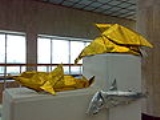
Sonobe
Encyclopedia

Modular origami
Modular origami, or unit origami, is a paperfolding technique which uses multiple sheets of paper to create a larger and more complex structure than would be possible using single-piece origami techniques...
, created by Mitsunobu Sonobe.
Each individual unit is folded from a square sheet of paper, of which only one face is visible in the finished module; many ornamented variants of the plain Sonobe unit that expose both sides of the paper have been designed.
The Sonobe unit has the shape of a parallelogram
Parallelogram
In Euclidean geometry, a parallelogram is a convex quadrilateral with two pairs of parallel sides. The opposite or facing sides of a parallelogram are of equal length and the opposite angles of a parallelogram are of equal measure...
with 45 and 135 degrees angles, divided by creases into two diagonal tabs at the ends and two corresponding pockets within the inscribed center square. The system can build a wide range of three-dimensional geometric forms by docking these tabs into the pockets of adjacent units.
The most popular intermediate model is the augmented icosahedron
Icosahedron
In geometry, an icosahedron is a regular polyhedron with 20 identical equilateral triangular faces, 30 edges and 12 vertices. It is one of the five Platonic solids....
, shown at right. It requires 30 units to build.
Three interconnected Sonobe units will form an open-bottomed triangular pyramid with a right-angle apex (equivalent to the corner of a cube
Cube
In geometry, a cube is a three-dimensional solid object bounded by six square faces, facets or sides, with three meeting at each vertex. The cube can also be called a regular hexahedron and is one of the five Platonic solids. It is a special kind of square prism, of rectangular parallelepiped and...
) and three tab/pocket flaps protruding from the base. This particularly suits polyhedra that have equilateral triangular faces: Sonobe modules can replace each notional edge of the original deltahedron
Deltahedron
A deltahedron is a polyhedron whose faces are all equilateral triangles. The name is taken from the Greek majuscule delta , which has the shape of an equilateral triangle. There are infinitely many deltahedra, but of these only eight are convex, having 4, 6, 8, 10, 12, 14, 16 and 20 faces...
by the central diagonal fold of one unit and each equilateral triangle with a right-angle pyramid consisting of one half each of three units, without dangling flaps. The pyramids can be made to point inwards; assembly is more difficult but some cases of encroaching can be obviously prevented.
The simplest shape made of these pyramids, often called "Toshie's Jewel", named after origami enthusiast Toshie Takahama, is a three-unit hexahedron built around the notional scaffold of a flat equilateral triangle (two "faces", three edges); the protruding tab/pocket flaps are simply reconnected on the underside, resulting in two triangular pyramids joined at the base.
Building pyramids on a tetrahedron
Tetrahedron
In geometry, a tetrahedron is a polyhedron composed of four triangular faces, three of which meet at each vertex. A regular tetrahedron is one in which the four triangles are regular, or "equilateral", and is one of the Platonic solids...
results in a cube (the central fold of each module lays flat). The same construction for an icosahedron
Icosahedron
In geometry, an icosahedron is a regular polyhedron with 20 identical equilateral triangular faces, 30 edges and 12 vertices. It is one of the five Platonic solids....
(20 faces, 30 edges) requires 30 Sonobe units.
Uniform polyhedra can be adapted to Sonobe modules by replacing non-triangular faces with pyramid
Pyramid
A pyramid is a structure whose outer surfaces are triangular and converge at a single point. The base of a pyramid can be trilateral, quadrilateral, or any polygon shape, meaning that a pyramid has at least three triangular surfaces...
s having equilateral faces; for example by adding pentagonal pyramids pointing inwards to the faces of a dodecahedron a 90-module ball can be obtained.
Arbitrary shapes, beyond symmetrical polyhedra, can also be constructed; a deltahedron with 2N faces and 3N edges requires 3N Sonobe modules.
There are two popular variants of the main assembly style of three modules in triangular pyramids, both using the same flaps and pockets and compatible with it:
- Joining four modules together (instead of three), forming a flattened square pyramid that can become part of a quilt or a larger polyhedral face, e.g. in 12 and 24 modules large cubes.
- Joining only two modules, forming a triangular fin that can be used as an ornament for suitable models and to make a 1 module triangle (one fin, made with the two halves of the same module) or a 2 module square (two fins).
The popularity of Sonobe modular Origami models derives from the simplicity of folding the modules, the sturdy and easy assembly, and the flexibility of the system.

